Although off-street car parks (at grade and buildings) are places to store vehicles, they are shared by people walking, cycling and driving. The scale of an off-street car park will vary depending on the associated land use. Facilities such as Park and Rides will generally have large car parks.
Once parked vehicle occupants get out of their cars they generally walk to and from their destination. Car parks need therefore to be safe and accessible for all users, including the destination visitors arriving by walking or wheeling. As such car parks need to be designed to achieve low speed environments and have well defined pedestrian paths on key pedestrian desire lines.
In addition to safety, amenity should also be considered particularly in larger car parks.
Key requirements to ensure the safety of people walking within car parks include:
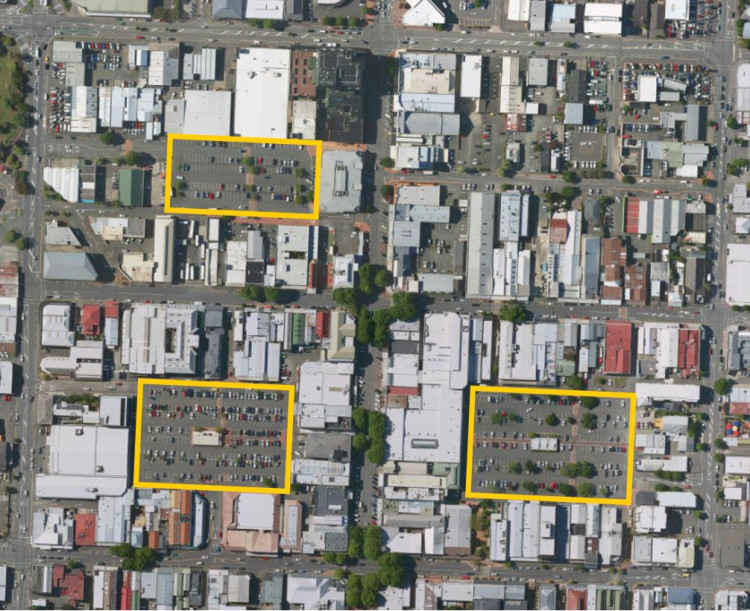
Parking squares behind buildings, Nelson City Centre. (Top of the South Maps)
As per the Traffic Control Devices (TCD) Rule, public car parks fall within the definition of a road as they are a place to which the public have access. Also, a road controlling authority (RCA) means the authority, body or person having control of the road; and includes a person acting under and within the terms of a delegation or authorisation given by the controlling authority. This therefore includes private landowners providing and managing car parks for public use, including commercial car parks, supermarkets, shopping malls, hospitals, airports and universities and other private landowners.
RCAs must install or operate traffic control devices to instruct road users of a prohibition or requirement that it has made concerning traffic under its control, so in the case of car parks any signs and markings need to clearly communicate the instructions. This can be done through use of TCD Rule signs and markings, or those that has been developed by the car park owner as long as these communicate the instruction.
There are a range of design considerations as discussed below; achieving a low-speed environment, catering pedestrians and ensuring safe entrance and exits. The figure below clarifies terminology used in the design discussions.

Example of an off-street car park layout. (Source: AS/NZS2890.1)
Low speed environments will ensure that if a crash was to occur between a driver and a pedestrian, it would occur at a speed that will minimise the risk of death or serious injury of the pedestrian. To achieve a low speed environment, the following needs to be considered:

Example of judder bar in a car park to slow vehicle speeds. (Photo: Jeanette Ward)
Appropriate signs and markings should be used as per the Traffic Control Devices rule to communicate the low speed environment to drivers using the car park. Speed limit signs indicating 10km/h can be used.
To minimise the risk of pedestrian and driver conflict within car parks, pedestrian paths should be well defined and accessible for people of all abilities and ages. A pedestrian path which is the safest and shortest route between the facility entrances and road frontage should be marked. This will encourage pedestrians to use the defined path and highlight key pedestrian movement areas to drivers.
Ideally, as soon people park their cars and exit their vehicle, they would have direct access to a separated footpath, leading to the car park exit or building entrance. This may not be possible in all situations due to space constraints, the key aspect is then to ensure a low speed environment is achieved.
Where a separated footpath can be achieved within the car park, there should be a kerb provided to protect pedestrians. The width of the path will need to account for the vehicle overhanging the kerb. Wheel stops should also be used when there are kerbed footpaths areas to prevent encroachment, particularly when a wide path cannot be achieved.
Where there is no height difference between the pedestrian path and the footpath, wheel stops should be installed to ensure that vehicles do not overhang over the footpath and narrow the path for pedestrians.
Wheel stops need to be considered carefully as they may cause a tripping hazard.
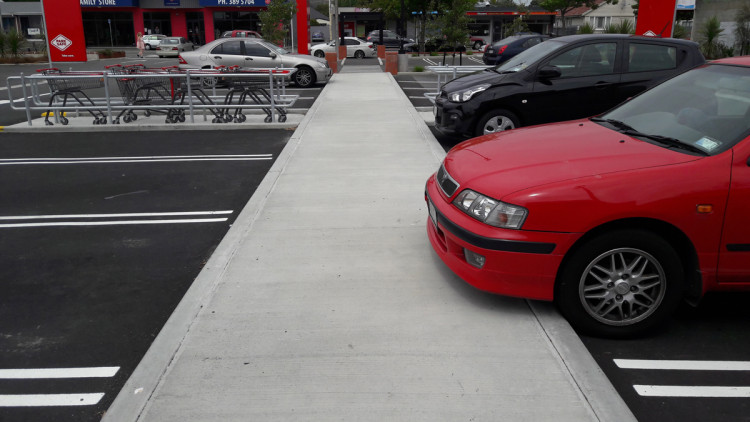
Kerb raises the footpath, but overhang encroachment results in poor and potentially unsafe path for people walking. (Photo: Jeanette Ward)

Flush footpath but with wheel stops to prevent overhang. (Photo: Jeanette Ward)
Ideally any pedestrian path within the car park should be formed in a different colour or material which distinguishes it visually from the surrounding ground surface. The defined path should also not lead to connections with poor accessibility.

Painted path leading to a connection with poor accessibility. (Photo: Jeanette Ward)
Footpath widths inside a car park should be wide enough to accommodate the expected pedestrian flows and will depend on the activity being served by the car park. A car park with less frequent turnover of spaces will likely function adequately with a 1.8m wide path, whereas wider paths will be required in supermarket car parks to accommodate higher pedestrian activity and trolleys.
Crossing of car park aisles and entry/exits, particularly on direct alignment to the building entrance/other destinations can be defined using various crossing types. Courtesy crossings or zebra crossings, preferably raised, provide clear locations where the majority of pedestrians accessing the car park from the street are likely to move through the car park.
For busy car parks it may be necessary to provide formal crossing points in the form of a zebra crossing.

Layout that caters well for the pedestrian desire line through the car park to the main entrance, Jellie Park, Christchurch. (Photo: Jeanette Ward)

Zebra crossing at an entrance to a mall car park, Northlands, Christchurch. (Photo: Jeanette Ward)
The design of the entry and exit to a car park needs to consider pedestrians and possibly other road users moving across the entrance, and pedestrians walking to and from the street.
Vehicle accesses can be designed as an intersection if certain criteria are met. When designed as a driveway, it needs to be obvious that drivers are required to give way to all other users (including pedestrians) when entering or leaving the roadway.
Providing adequate visibility at the accessway is important. A visibility splay, which is a space with no objects high enough to block sight lines between drivers and frontage path users, can provide clear sight lines.
For long accessways a footpath will be required.
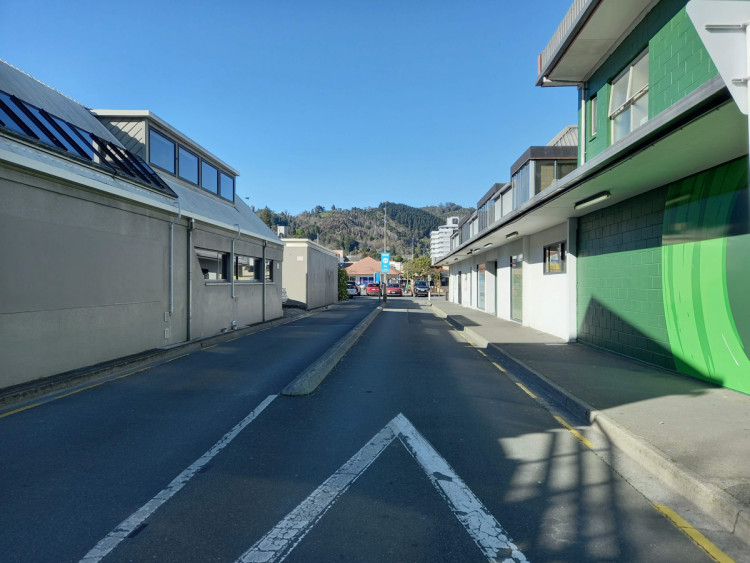
Entry/exit to the Montgomery car park with footpath, Nelson. (Photo: Jeanette Ward)
When a car park includes landscaping and other above ground features, these need to be designed to ensure people are kept safe from other people. This requires adopting Crime Prevention through Environment Design (CPTED) principles.
Accessible parking spaces are provided for use by people with mobility-related impairments. These parking spaces may be used only by holders of Current Operation Mobility permits issued by organisations such as CCS Disability Action.
These dedicated spaces are generally a requirement of District Plans. They are marked with a yellow line marking and display the wheelchair symbol. Some car parks have the symbol on top of blue surfacing that make the space stand out. They are wider than standard spaces to allow for manoeuvrability of mobility devices out of and into the vehicle. They should be located as close as possible to the building entrance or key destination within the car park. A kerb ramp is required to facilitate level access between the parking space and footpath area. The manoeuvring space between the car park space and the footpath needs to be kept clear of obstructions such as street furniture.
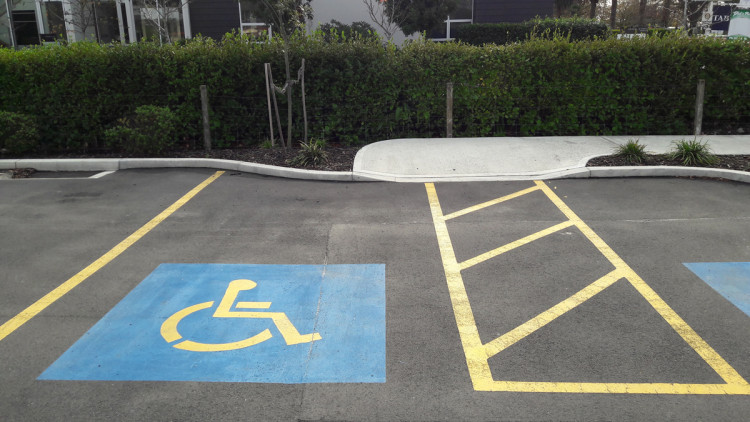
Good example of an accessible parking space. (Photo: Jeanette Ward)
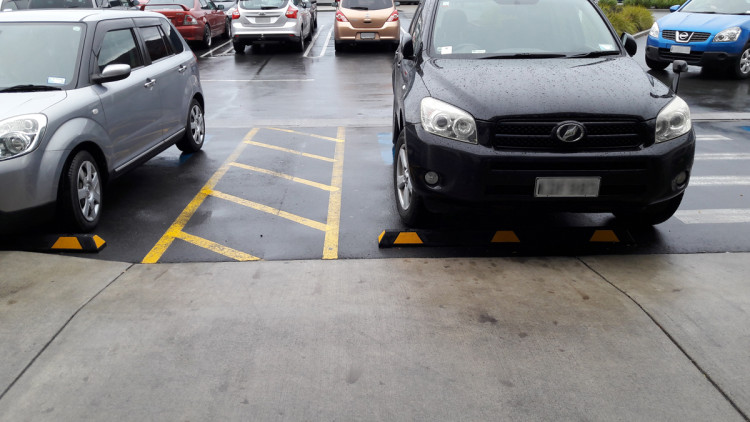
Good example of accessible paths being kept clear. (Photo: Jeanette Ward)
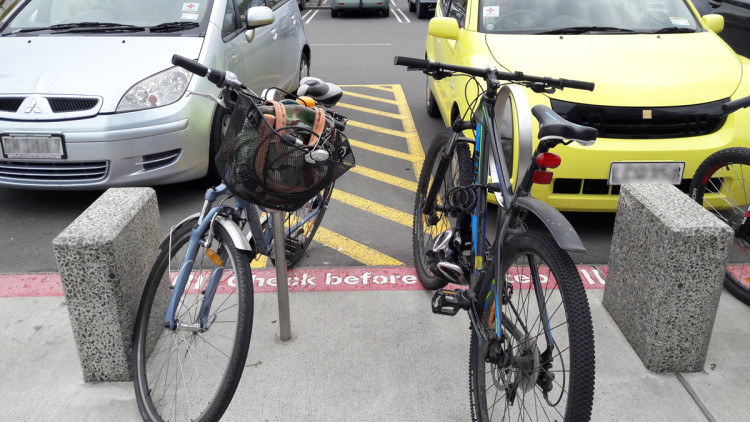
Poor example where cycle parking has blocked the accessible path. (Photo: Jeanette Ward)
Lighting must be considered for any car park which is to be used at night. As well as lighting the parking and circulation areas, pedestrian pathways and crossing points must be adequately lit. Minimum lighting levels are outlined in AS/NZS 1158.3.1.
AS/NZS 1158.3.1:2020 Lighting for roads and public spaces – Part 3.1 pedestrian area(external link)
RCAs generally have off-street car park layout requirements in their District Plans, this includes dimensions for each space and the aisle between them. Further guidance can be found in Waka Kotahi guidance and Australian/New Zealand Standards.
Traffic Control Devices Manual Part 13 [PDF, 690 KB]